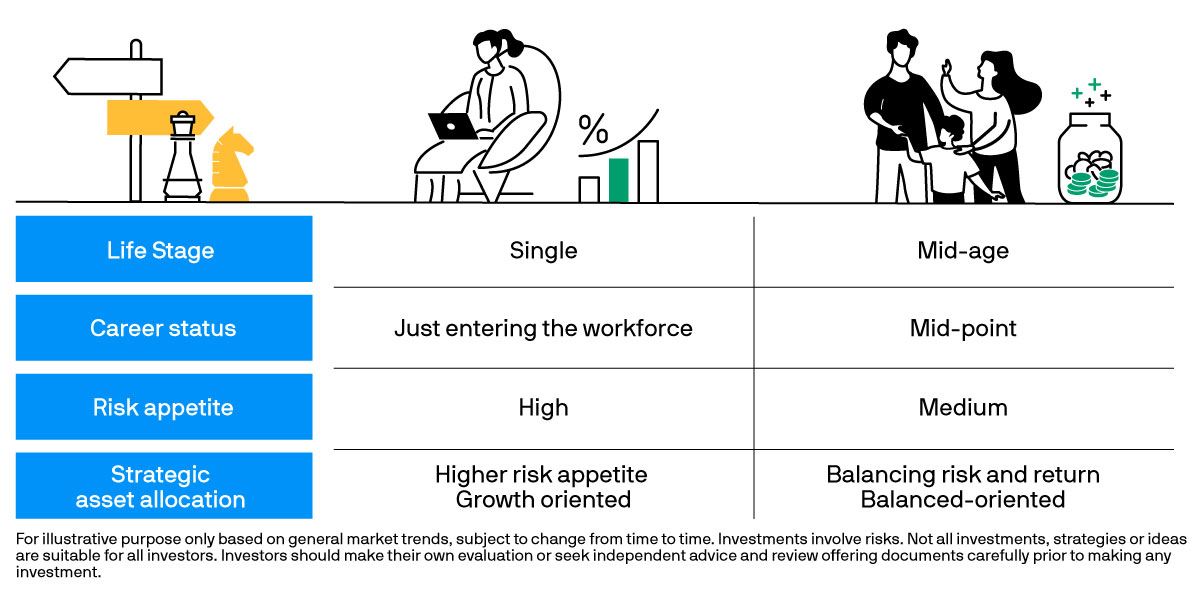^ Terms and conditions apply.
Taking the first step in investing
Investing can be quite puzzling for some young adults as they know that investing could be one of the effective ways to build wealth, but often, they lack the knowledge on how and when to begin.
Before starting on an investment journey, a key step is to define specific goals based on life’s different stages and needs, and craft a plan.

Whether investors are in their twenties or forties, it is optimal to keep in mind these investing principles on an investment journey.
1. Long-term investing
Time can be an investor’s best friend. It is important for investors to start saving and investing early in order to maximise the benefits of compounding. For example, if a young investor allocates HK$3,000 every month for long term saving and investment, and assuming an annualised return rate of 5.5%, there is the potential to grow the investment to HK$1.307 million in 20 years1.
2. Staying invested
Some investors are often challenged by their emotions and natural biases, and can make ill-timed investment decisions after surrendering to their heightened emotions. Moreover, it can be tough to accurately time a market entry or exit, and frequent trading may risk losing out on opportunities and returns. Investing regularly can help investors take advantage of “dollar cost averaging” while navigating market volatility.
3. Diversification in investing2
No single asset class can be an all-time winner. Investing all funds on a single or a small number of assets could increase concentration risk. Through active investing, investment professionals could employ different strategies to add equities, bonds or other types of assets in a mutual fund portfolio to capture potential opportunities and optimise the benefit of diversification.
4. Choosing a trusted partner
While choosing whether or not to invest with an asset manager depends on your own circumstances, a trusted partner may help enrich your investment journey. Your plans may change when your life-stage changes. Fund managers that can provide a large variety of products and comprehensive services can provide you with different choices when fulfilling your changing needs. When choosing an investment partner, investment performance should not be the only consideration but a totality of level of services counts. Experience of investment teams, frequency of receiving recognitions are also some of the gauges that investors can make reference of.
#IFEC #TheChinFamily #HKMoneyMonth2024 #HKMM2024 #SavvyInvestor #BeVigilant #UnderstandThoroughly #ThinkCarefully
J.P. Morgan Asset Management is among the supporting organisations of Hong Kong Money Month 2024. Find out more.

Build stronger portfolios with insights

1. Source: Investor and Financial Education Council’s “Financial calculator widgets – Saving and investment calculator”. The calculator does not take into account certain factors such as changes in inflation rate and rate of return. The calculator shows how your savings and/or investments grow with compound interest. The result, calculation and chart are presented as the best estimates for reference and illustrative purposes only and should not be considered as the only source of information when making investment decision. Please consult your investment advisors or financial planners for professional guidance.
2. Diversification does not guarantee investment return and does not eliminate the risk of loss.
Provided for information only based on market conditions as of date of publication, not to be construed as offer, investment recommendation or advice. Forecasts, projections and other forward looking statements are based upon current beliefs and expectations, may or may not come to pass. They are for illustrative purposes only and serve as an indication of what may occur. Given the inherent uncertainties and risks associated with forecast, projections or other forward statements, actual events, results or performance may differ materially from those reflected or contemplated.
Investment involves risk. Not all investments are suitable for all investors. Past performance is not a reliable indicator of current and future results. Please refer to the offering document(s) for details, including the risk factors. Investors should consult professional advice before investing. Investments are not similar to or comparable with fixed deposits. The opinions and views expressed here are as of the date of this publication, which are subject to change and are not to be taken as or construed as investment advice. Estimates, assumptions and projections are provided for information only and may or may not come to pass. This document has not been reviewed by the SFC. Issued by JPMorgan Funds (Asia) Limited.

